I. Introduction
Television viewing is regarded by most in our society as a recreational pastime and an escapist form of entertainment. Yet media theorists hold the position that television viewing is not the passive activity that we might assume. John Fiske assigns a significant role for television in Western society, maintaining that television is a cultural agent, serving as "a provoker and circulator of cultural meanings."1 For Fiske, television circulates these cultural meanings by bringing forth and manipulating an elaborate and complex hierarchy of codes which television viewers interpret in the context of their own discursive universes. Fiske's "codes of television," illustrated in Figure 1, are arranged in a three-leveled hierarchy consisting of "reality," "representation," and "ideology."2
Figure 1. Fiske's "Codes of Television."
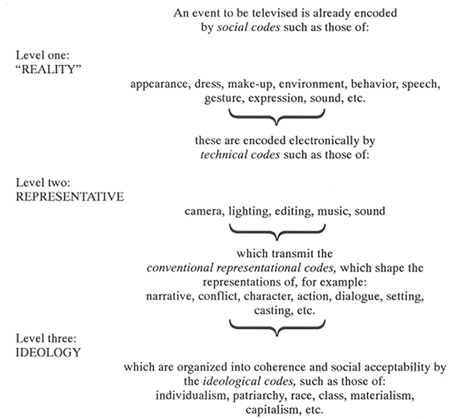
Fiske's diagram reveals a hierarchical semiotic structure in which physical objects (signifiers) occur at the top of the diagram, while abstract ideologies (signifieds) are found at the bottom. It also illustrates a multi-leveled structure where signs combine to form codes in a hierarchical arrangement. At the top of the diagram, "reality" is represented by social codes such as the physical appearance, dress, make-up, behavior, speech, and gestures of characters on television, but also encompasses other aspects such as the physical environment and sound effects on the screen. While all of these codes are "real," that is, they exist in the physical world outside of television, their portrayal on television is mediated, and never "raw." The presentation of these physical realities on television is subject to certain social conventions of American society, such as appearance, costume, and form of address in speech, to name a few. Thus, while Fiske's hierarchy deals explicitly with "televisual" reality, one might imagine an extension of his diagram to include unmediated objects or pure signifiers above level one.
These "realistic" social codes are mediated (or encoded) electronically by technical codes which comprise one portion of the second level, that of "representation." The representational level consists of two sublevels: technical codes and conventional representational codes. "Technical codes" include camera, lighting, editing, music, and sound. These are technical conventions developed through the medium itself for representation of reality. These codes may be seen as signifiers that manipulate the social codes to correlate with the signifieds of the "conventional representational codes." As signifieds, conventional representational codes serve as a locus of meaning in the television text, or a point where a "crossover" from signifier to signified occurs. For example, the camera is used through angle and deep focus to provide a view of a scene or character in a television narrative. A close-up shot will provide the viewer with a sense of intimacy with a character, while a long shot may provide a sense of alienation or detachment from a character. While the camera is a technical apparatus, the way it is used in television triggers many representational conventions learned by viewers. Other technical codes act in a similar way: make-up, lighting, editing, dialogue, character appearance, and music all contribute to representation and meaning in television.
The representational codes signify various narrative and character types found on television. In turn, they serve as signifiers that correlate with the ideologies of culture, as listed by Fiske on level three. In addition to its importance as the point at which the technical codes are signified, the conventional representational level has a double function as both signifier and signified within the hierarchy of codes. The conventional representational level is the link to signification in the television text through its ability to serve as signified of the immediate text, and to serve as signifier of the underlying ideology of the text. The technical codes are manipulated by the producers of television texts and coalesce into meaningful representational codes when interpreted by the television viewer. The viewer then organizes these representation codes and assimilates them into ideological codes of coherence and social acceptability . Fiske maintains that ideological codes that are at work most in television are those that seek the largest segment of the audience. These ideological codes are also those that tend to maintain a social status quo. Fiske cites some prevalent ideological codes for television as individualism, patriarchy, race, class, materialism, and capitalism, though many other ideologies may be conveyed in television.
While a television text is the result of the confluence of all the technical codes, each of these codes contributes in its own way to the signification process of the "whole" text. As one of the technical codes of representation in a television text, music can play a significant role in the transmission of conventional representational codes. Furthermore, music in television may be seen to function in a way similar to Fiske's codes of television in conveying meaning to the viewer. Music can be viewed as containing a hierarchy of codes within itself, and this hierarchy contains its own level at which the musical signifier meets the signified.
In this article, a hierarchy of music codes is constructed for music in television using Fiske's hierarchy as a model. The hierarchy is structured following an analytic perspective of music that considers the diachronic, or syntagmatic, and the synchronic, or paradigmatic aspects of music. Both analytic perspectives of music lead to a multi-leveled analysis in which the musical style topic serves as the locus of meaning for music in television. In the second part of the article, the musical style topic is illustrated by the concept of American radio formats. The final portion of the article is a semiotic analysis of music and other technical codes in two television commercials, one for Infiniti automobiles and the other for Chevrolet trucks. Television commercials are used here because of their brevity. As is demonstrated in the analyses however, brevity does not always equate with simplicity. The two commercials examined each illustrate a composite of musical style topics and many possible ideologies.
II. The Analytic Method
a. Paradigmatic and Syntagmatic Analysis of Media Texts
Music and television share some important attributes which make the analysis of each similar. Unlike print media, music and television are both ephemeral in nature. It is not possible to review a television text or a musical text in the way a newspaper reader or book reader can glance back over the page (at least not without a video and audio tape machine!). Nor is it really possible to stop the real-time nature of either medium in order to analyze an event fully. Because music and television share the same sort of "real time" presentation, it is useful to analyze them in the same way. Borrowing from the linguistic theories of Ferdinand de Saussure, theorists frequently analyze media texts according to two broad categories: the syntagmatic, or diachronic, and the paradigmatic, or synchronic.3 Such an analytic method is useful in describing both the temporal process of a media text and the referential qualities of the structures exhibited within this temporal process.
A syntagmatic analysis of a media text would involve an account of the temporal process of various parameters of the text. Though such an analysis may be significant, there is a tendency for the analyst to "paradigmatize" the syntagmatic analysis. This analytic tendency is shown later in this paper. The paradigmatic, or associative aspects of a media text would include those parameters which can be categorized and compared/contrasted to other similar parameters. Paradigmatic analyses of television texts usually involve the metaphor of viewing the text from a "vertical" perspective. A common analogy of the paradigmatic in television is the daily broadcasting log of television stations found in the newspaper. We look at the schedule of programming for a certain station and compare that programming with that of the other stations. (Newspaper television logs even present programs in the same time slots vertically). A more significant paradigmatic theoretical approach to the analysis of television has been a paradigmatic analysis by genre. This approach is multi-leveled. First, we may categorize television programs by pre-existing genres (westerns, cop shows, situation comedies, etc.). On another analytical level, we may compare the programs that fall within a particular genre (situation comedies such as "Cheers" compared with "Seinfeld," for example). On still another level, we can inventory particular scenes within one program and compare them. This process is hierarchical and can continue down to the smallest unit of the text.
For the analysis of music in the electronic media, it is useful to view the musical text in the same two broad categories of signs. First, we may view music on television paradigmatically, or as a sequence of topical or referential signs. This analysis would involve the identification of various referential topoi and their subsequent classification within a referential inventory. Secondly, we may apply an analysis of the temporal sequence of the music itself. Music theorists utilize this sort of analysis all the time in delineating the form and design of musical art works.
Paradigmatic aspects of music would include aspects of musical structure that can be categorized and inventoried. Like the example of the television text, a paradigmatic analysis of music is multi-leveled. On one level, musical paradigms would include whole works such as symphonies, overtures, songs, etc. Another level would include individual movements or sections within a piece. We can construct hierarchical levels of musical paradigms down to the smallest units: from collections of pitch patterns, rhythmic patterns and timbres down to individual pitches, beats, and tone colors.
The syntagmatic analysis of a media text involves the temporal process, yet this process is difficult to describe without invoking some sort of paradigmatic structure. For example, David Bordwell and Kristin Thompson describe five "types" of syntagmas in describing temporal form in film.4 Among these five types of syntagmas is narrative form, one of the most prevalent on television. Other media theorists have developed or adapted various theories of narrative from literary and film theory, but a characteristic syntagmatic structure for television narratives has been devised by Jeremy Butler. Butler claims that a television narrative involves seven steps: (1) single or multiple protagonists who, (2) are established through an exposition; 3) the protagonist's desire catalyzes the story; 4) a central enigma underpins the story; 5) the narrative progresses by means of an antagonist delaying the resolution through an enigma; 6) the conflict of protagonist/antagonist reaches a climax; and 7) closure is achieved through resolution of the conflict.5
Despite Butler's (and others) attempts to describe the temporal process of a text, ultimately syntagmatic structures are described paradigmatically. Butler's description of a story is frequently listed as a "narrative" syntagm, one of five different syntagmas according to Bordwell and Thompson. One certain type of syntagm may be inventoried and compared with another. Thus, the analysis of syntagmas is actually an analysis of "paradigms of syntagmas." These paradigms contribute to an additional (and quite useful) category for the paradigmatic analysis of a text. Furthermore, the components of such narrative syntagmas have been categorized by theorists such as Vladimir Propp, further creating paradigms from the syntagmatic structure.
A syntagmatic analysis of music is conceptually similar to that of the television text as a whole. Terms invented by music theorists to describe musical processes (binary, ternary, sonata, rondo, etc.) are actually paradigmatic. These labels are referential outside of the musical text itself and are associative with other musical processes. In music in the media, another way to apply syntagmatic analysis is to seek out rhetorical or narrative isomorphisms between the musical codes and the other codes of the media text. Comparisons of music with narrative or rhetorical models is a time-honored tradition.6 In a recent study, Littlefield and Neumeyer seek to define the parameters of narrativity in music:
Narrativity, of a verbal or musical text, requires goal-directed motion, a transformation of the initial situation during the course of actions, and logical or causal entailment between beginning and end, all under the control of a "deep structure" or combinatoire, a set of organizing functions that controls a textual surface.7
In music, the types of musical processes at work in a piece may be inventoried and thus become paradigmatic. For the purpose of the analysis of television music, we shall consider the "goal-directed motion" and "logical or causal entailment between beginning and end" of the music within a text. Ultimately, however, this syntagmatic analysis leads to the description of the "deep structure" of the process, a description which is essentially paradigmatic.
Before describing in full the analytic method constructed here, a note on the signifying potential of syntagmas and paradigms is in order. A useful way of viewing how paradigms and syntagmas contribute to signification within a text is offered by linguist Roman Jakobson. Jakobson distinguishes between two types of semiosis within a text: extroversive and introversive.8 Extroversive semiosis is defined as "the referential link with the exterior world." In the discourse of music, everything non-musical is the exterior: the remaining technical codes of the commercial, the non-musical text of the commercial itself, as well as all external references and correlations. In the context of an analysis of music in television, all other technical codes of the TV text as well as the conventional representational codes and ideologies would be extroversive. Extroversive semiosis occurs when there is a correlation of music with the other technical codes of the commercial (through some isomorphisms or iconically motivated signs ) and/or a correlation of music with the intertextual universe outside of the commercial (through some symbolically and indexically motivated signs). For example, when hearing a march played by a brass band, we might associate the music with the military, with our experiences as members of a high school or college marching band, with famous band conductors like John Phillip Sousa, etc. Conversely, introversive semiosis is defined as "the reference of each sonic element to the other elements to come." In introversive semiosis, signification occurs through the internal structure of the text. Music, like language, can convey its own internal structure and thus convey an introversive semiosis on the basis of its internal structure. However, in television, this internal structure can be associated externally with other technical codes of the television text. Introversive semiosis thus become extroversive.
For the purpose of analyzing music on television, we can construct a hierarchy of musical codes similar to Fiske's "codes of television" for the "whole" television text. Like the codes of television, musical codes are paradigmatic structures that organize themselves on three basic levels of signification.
Figure 2. The Codes of Television Music.
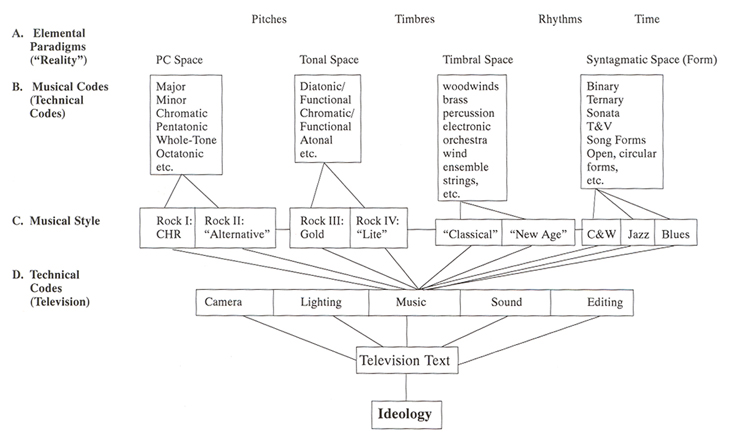
Like Fiske's hierarchy, Figure 2 illustrates musical "reality" or pure signifiers at the top of the graph. At level A are the elemental musical structures of pitch, rhythm, timbre, and time which are, in turn, organized into larger musical codes at level B. I have labeled this paradigmatic level as musical "spaces" to include pitch-class, tonal, rhythmic, formal, and timbral groupings.9 These "spaces" are similar in nature to Fiske's technical codes for television in that they are the raw materials used for the manipulation of musical style. They are musical codes in the true sense: they are a complex of signs that form an aggregate for signification. Pitch-class space refers to any collection or genus of pitches: major, minor, pentatonic, chromatic scales, or any other aggregate of pitches. Tonal space is a paradigm that refers to the syntagmatic process of pitch centricity, and how pitch centricity is achieved. Tonal space may include functional diatonic tonal space, chromatic tonal space, or other means of establishing or eschewing pitch centricity. Timbral space deals with the combination of sounds and instruments from conventional timbres or groups of timbres (orchestra, string quartet, rock band) to unconventional combinations of musical timbres. Finally, as described above, "syntagmatic space" describes the type of musical form or temporal design within a television text. For the purpose of this study, we shall examine musical syntagmatic space in terms of tonal closure. Those syntagmatic spaces that exhibit tonal closure (opening and closing on a tonic) are called "closed," while those that exhibit tonality but do not end on tonic are called "open."
b. Musical Style Topics in Television
Level C of the Figure 2 represents the coalescence of the technical codes of music from level B to form musical "style topics." Style topics have been described and defined by several authors, most notably Kofi Agawu, Leonard Ratner, and Eugene Narmour.10 Agawu describes the style topic as follows:
Topics are musical signs. They consist of a signifier (a certain disposition of musical dimensions) and a signified (a conventional stylistic unit, often but not always referential in quality). Signifiers are identified as a relational unit within the dimensions of melody, harmony, meter, rhythm, and so on, while the signified is designated by conventional labels . . .11
Agawu explains that topics are subjects of musical discourse and that they provide a framework for describing various kinds and levels of associative signification in music. The world of topic, like its parent world of the sign, is potentially open, so that one cannot specify the total number of topics current in a particular musical style. Since musical style topics are "open" signs, their component parts may vary greatly. Some style topics may consist of a single melodic gesture, others may involve a specific combination of instruments/timbres, still others a more extensive combination of musical parameters. Also, since topics are referential, their origin must come from the culture in which they exist. As shown below, the referential basis for many musical style topics on television is extroversive and intertextual, originating in other electronic media such as radio and music video.
The style topic is similar in nature to Fiske's conventional representational codes. It is the ability of the musical style topic to signify outside of the internal structure of the music itself that this parallel can be drawn. An example of this extroversive semiosis is the correlation that members of a culture make with music and other aspects of culture.12 First, correlations are commonly made between music and certain venues of musical performance. In American culture, one may correlate Country-Western music with a neighborhood bar, or rock music with a smoke-filled domed stadium, or Classical music with a finely-architectured urban concert hall. Secondly, correlations may be made with music and certain demographic groups of people. One may correlate Country music with rural white populations, Rap, Hip-Hop, or Soul music with urban black populations, Heavy Metal rock music with males aged 18-22, or Classical music with the wealthy upper-class. Though these correlations produce and promote cultural stereotypes, they rely on common assumptions which in turn are exploited by the electronic media.
Like Fiske's representational codes, style topics may be thought of as the point where the non-referential structure of the music engages a referential component of the listener, or where the signifier meets the signified. The condition for the definition of a style topic is listener's competency with the music of a given culture. At the level of the style topic, pure musical signs begin to cohere into meaningful structures: they occur at a significant point in the paradigmatic hierarchy in that they represent the poietic coherence of lower-level pure signs into larger signs which signify through the esthesic perception of the listener. Signification between music and non-music is also recursive and reflexive: style topics may serve as referential paradigms for a certain aspect of culture, just as certain aspects of culture may refer back to aspects of musical style. One prominent illustration of this relationship can be found in American society's relationship with format radio.
c. American Format Radio
The style topics identified for television on level C of Figure 2 reflect labels that are currently used to describe the various musical formats used in American radio. The format system of radio provides a practical illustration on the role of style topics in the electronic media (including television) today. A "format" is defined by Rothenbuhler and McCourt as "a style, genre, or system that defines the musical or informational boundaries of what a [radio] station will present and its overall approach to programming."13 This somewhat vague definition of the format coincides with Agawu's criteria of the "open" musical style topic. Radio formats are "open" in that, while they consist of a coalescence of musical paradigms that create the technical code of the style, they are defined by the participants of the culture. The more participants in culture, the greater the disparity of definitions of a style. As a contemporary example, the style topic of "rock" would consist of slightly different musical technical codes from one listener to another. Secondly, formats are "open" in that they are constantly changing over time periods. For example, what we now call "Gold" or "Nostalgia" on radio was once "Contemporary Hit Radio" one or two generations ago. Conversely, new formats are created with each new generation of radio: there was no such format as "Alternative" twenty years ago. Formats are thus flexible and have no definite structures, only generic tendencies.
Among others, Ken Barnes has conducted research on the demographics of format radio. In his 1987 article, Barnes traces the development of format radio and how the format system has fragmented the radio-listening audience. He identifies some twenty-five different radio formats (seventeen of which are delineated by the style of music played—the other eight are classified by non-musical aspects such as "talk," "news," "sports," etc.). He describes formats as tools for targeting specific audiences in terms of the demographics of ethnicity, age, and socio-economic groups.14 This targetting process has resulted in the fragmentation and polarization of the radio-listening public in order to build a market "niche" for individual radio stations.
Barnes's study offers a practical application of the idea of the musical style topic. Following Barnes's diagram, I offer my own paradigmatic list of style topics for music in television in Figure 3. This "universe of the style topic" can also be compared to those provided by Agawu and Ratner for eighteenth century music.15
Figure 3. The Universe of the Style Topic.
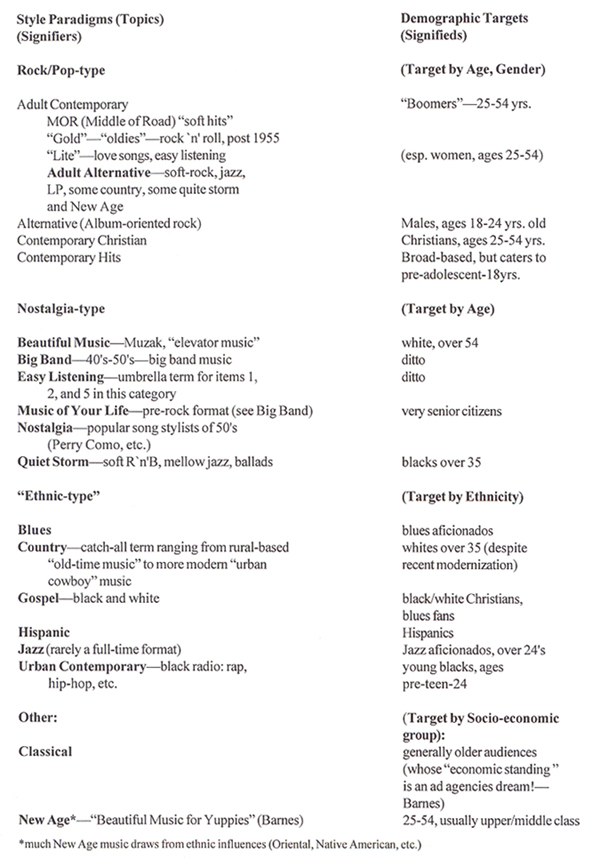
The diagram represents an "expanding" universe of musical style because of the open nature of the style topic. Besides the conditions for openness listed above, style topics may be considered open because they do not always have the same referential qualities, that is, they are not labeled the same by all members of the participating culture. For example, Figure 3 illustrates seven style topics for what musicologists might categorize under the single heading of "Rock" or "Pop" music, while the prospect of a single category for "Classical" music would be absurd for these same musicologists, as it completely negates the multifarious style periods which are covered in academe. The "universe" in Figure 3 is thus not "fixed," but is constructed from a set of topics that reflect those that are used by the electronic media.
As American format radio illustrates, musical style topics are the conventional representational codes of music. While the "musical spaces" of the paradigmatic hierarchy serve as the technical codes of music, style topics serve as both signifier and signified of various aspects of culture including demographic groups. In radio, style topics serve as a consumable product aimed at a certain socio-economic group. Beyond radio, however, style topics become reflexive of that group. In a mass medium such as television, a musical style topic may be used to "represent" or signify a demographic group. Conversely, a demographic group may transmit its own ideological codes through a style topic. When the musical style topics are used in television and combine with the other technical codes of television, each code tends to reinforce the other codes in a network of extroversive semiosis.
It is precisely this phenomenon that producers of television commercials exploit for the identification and targeting of socio-economic groups by the use of musical style topic in their commercials in order to convey the televisual message. Nicholas Cook has pointed to the use of style on television as an aspect of postmodernism: "Only with postmodernism has the idea of 'composing with styles' or 'composing with genres' emerged, at least as a consciously adopted procedure."16 However, we may ask how commercials are so adept at targeting audiences through the use of musical style topics? How can musical style identify these targeted audiences so easily? The following analyses demonstrate the points made with respect to the process of semiosis and ideology in television commercials.
III. A Tale of Two Vehicles: Syntagmatic and Paradigmatic Analysis of Music in Television Commercials
Having equated the musical style topic with contemporary format radio, we may now apply the notion of the musical style topic to television texts. Like radio, television advertising uses musical style to target specific audiences thus enticing them to purchase products. Musical style also serves to build an isomorphism between the product and the demographic group that the style signifies. Unlike radio, television compounds the signifying process through the combination of the other technical codes of television: the visual codes of the camera and tape editing; and the other sound codes such as sound effects and dialogue. Presumably, these other technical codes bring to the television text the same hierarchical structure for signification as that described for music above, and for Fiske's hierarchy of the codes of the "whole" television text. Tracing these hierarchies is outside the scope of this study. However in the analyses below, we shall draw upon certain aspects of these other codes to illustrate the efficacy of the signifying process in commercial television.
To show how musical style topics interact with other technical codes to produce ideologies, we shall apply an analysis to two television commercials which aired on American television during the early 1990's. Both commercials are for vehicles: one is for Infiniti automobiles, considered a luxury car; and the second is for Chevrolet trucks, considered a "blue-collar" working truck. Though selling the same type of product, the commercials are very different in the use of technical codes. The Infiniti commercial is essentially a comical narrative, with a protagonist (a woodpecker), antagonist, (the narrator), and a narrative enigma. The Chevy truck commercial relies heavily on the visual cinematic technique of montage. Through analysis of the technical codes, we will see how the music reflects these different approaches to production in the commercial.
a. Luxury as Ideology: The Infiniti Automobile
An analysis of the technical codes for the Infiniti commercial is illustrated as Figure 4.17
Figure 4. Analysis of the Infiniti Commercial.
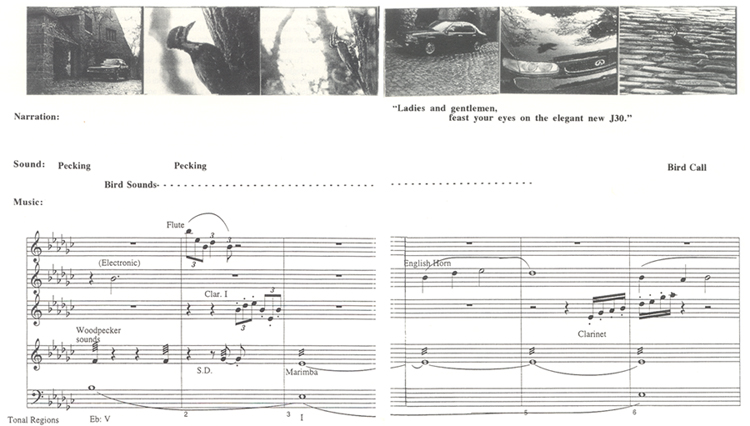
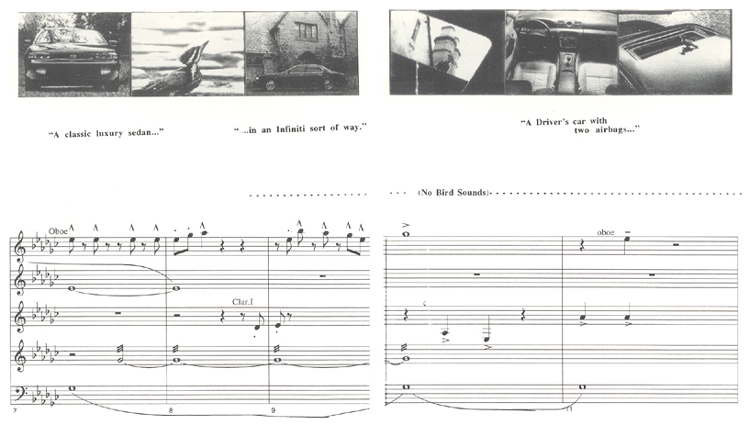
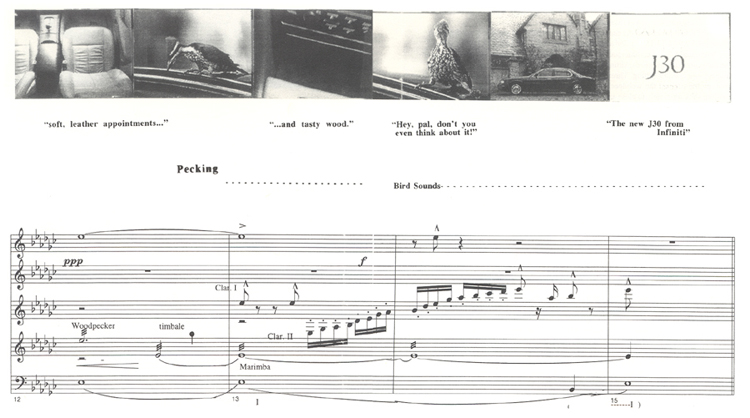
At the top of the diagram is a synopsis of the visual camera "shots" of the commercial. The second line represents Fiske's technical code of dialogue (or in this case, monologue). The third line portrays the technical code of sound effects, while at the bottom of the page is my transcription of the musical "score."18
In the visual parameter, the camera shots alternate between shots of the Infiniti car (shots 1,4,5,7,9,11,13,15,17), and a woodpecker (shots 2,3,6,8,10,12,14,16), our narrative "protagonist." The commercial opens with a camera shot of a woodpecker on a tree, and then cuts to the Infiniti car sitting on a cobblestone driveway in front of a large house situated in a country setting. Throughout the commercial, the camera shots alternate between the car and the woodpecker. The shots of the car move from long-shot to medium shot, ultimately to close-up of the interior, becoming progressively larger and larger, giving the effect that we, the viewers, are approaching the car and "climbing in." The shots of the woodpecker, however, are less systematized, alternating between close-ups and medium shots. Nested within this visual structure is a tripartite structure of long-shot/close-up/long-shot scheme. Shots 1-9 are virtually long shots, while shots 10-16 are close-ups of both car interior and bird. The final shot pulls away to a long shot of the car, with the bird flying away above the car. The "Infiniti J30" logo at the end of the ad serves as a visual "coda," and provides the only instance of written text in the commercial.
The tripartite syntagmatic structure of the visual shots is reflected in the other technical codes of the commercial. In the opening and ending of the commercial, bird sounds are audible, while in the middle of the ad, the bird sounds are faded out. Thus, sound effects follow a sort of three-part (ABA) design. Douglas's narration is even organized in a three-part structure, similar to that of classical rhetorical models. "Ladies and Gentlemen, feast your eyes on the elegant new J30," serves as the introduction or Exordium. Following is a description of the car's features or Narratio. Finally, Douglas breaks from the rhetoric and enters the narrative by admonishing the woodpecker: "Hey, pal, don't you even think about it!" referring to the woodpecker's viewing of the "tasty wood interior" of the car. Finally, the rhetorical Peroratio: "The new J30 from Infiniti."
Like the other technical codes in the ad, the music composed for the commercial also follows the three-part structure. The top three staves of the musical score represent the actual musical activity of the piece, while the bottom score is a reductive diagram showing tonal centers. As shown on the score, the music of the commercial is tonal, using ahemitonic pentatonic pitch material centered on E-flat. One way in which the three-part structure manifests itself is through a key scheme in the "piece," though the music is so brief and the instrumentation is so sketchy that tonal centers are defined largely through their assertions in the bass. The music opens on the pitch B-flat which serves as dominant of E-flat. Tonic is asserted by measure 3. The middle section is marked by motion to the mediant, G-flat. The final section is marked by the re-statement of E-flat as tonic in measure 12. Our little tonal design even concludes on an authentic cadence (V-I) in measure 14-15. The commercial exhibits a three-part form through the deployment of themes. After a three measure introduction, a "principal theme" is played by an English horn in measure 4-6, with a contrasting theme in the oboe in m. 7-10. A denouement occurs with a flourish in the clarinets in measures 13-15.
In addition to its three-part design, the Infiniti commercial is structured according to a narrative design. The woodpecker is one of the narrative protagonists, but we viewers are also made to be the protagonist, as both we and the woodpecker are made to "desire" the Infiniti car. As mentioned above, the visual shots establish the characters and space of the narrative. The narrative enigma(s) posed include questions like: "what is a woodpecker doing in this ad," or "how can I afford such a car." The antagonist is Michael Douglas, the announcer, as he carefully describes the features of the car and ultimately drives the woodpecker away in the denouement ("Hey, pal, don't you even think about it!"). Closure is achieved in the rhetorical peroration and the musical cadence, sounding along with the Infiniti logo (with the price—which resolves another enigma—whether or not viewers can afford it!).
The syntagmatic structure of the music of the commercial is isomorphic with other syntagmatic aspects of the commercial. The commercial is a closed narrative, and the music is tonally closed: the key of E-flat minor is introduced by its dominant; the tonal center shifts to G-flat; and another tonal shift results in the return to E-flat. Thus, tonally the score contains a distinct beginning, middle and ending, similar in many respects to a literary narrative.19 The tonally-closed design and the narrative correlate. This isomorphism of the musical, rhetorical, and narratological design of the ad unifies it and promotes an internal coherence, or introversive or intra-opus semiotic.
The internal coherence of the Infiniti ad is established through the syntagmatic structure of various technical codes. However, it is the paradigmatic, or associative aspects of the commercial that ultimately leads to signfication. The musical style topics exhibited in the commercial contributes to the extroversive signification. As figure 4 illustrates, the visual technical codes of the commercial convey a picture of wealth and luxury, particularly one with eighteenth-century connotations. The image of the very large house in the country with a cobblestone driveway conjures up associations of a "landed country gentry." The woodpecker lends a comic touch to the visual images, but also reinforces a Rousseauian notion of man's coexistence with nature (although humans also have dominion/control over nature). In addition to his classical rhetorical model, Douglas's narration contributes to the ambiance of luxury: in pointing out the attributes of the car, he uses words such as "elegant" and "soft, leather appointments" (for "seats"), even addressing the audience as "Ladies and Gentlemen." The focus of the ad is on the wood interior of the car, a feature limited only to the most expensive of autombiles. Overall, the visual and sound codes of the ad transmit the representation of wealth and luxury, which in turn conveys the ideology of materialism and social class (in this case, the upper class).
So how does the music of the commercial contribute to the ideologies expressed in the other codes? A paradigmatic analysis of the music serves to locate a style topic that supports the prevailing ideologies of the commercial. The paradigmatic "spaces" utilized in the commercial coalesce into two primary topics: the "New Age" and the "Classical." The "New Age" style topic is the result of the confluence of pentatonic pitch space and diatonic tonal space. Timbral space also transmits the "New Age" topic, as it involves the use of electronically-modified wind and percussion instruments. A second topic in the ad is the "Classical" style topic, transmitted through pitch, tonal, timbral, and syntagmatic spaces. While also transmitting the New Age topic, pitch-class and tonal spaces are tonal in the manner of functional tonality of classical music using the tonic-dominant polarity. Timbral space also signifies the Classical since it consists of traditional woodwind instruments found in classical ensembles such as the symphony orchestra, chamber music ensembles, etc. As described above, the syntagmatic space also signifies the Classical topic, as the three-part design of the musical score reflects the three part designs of many classical pieces. The tonally-closed design of the music in this commercial is the same used in many classical ternary forms and even in the classical minor-key sonata form: the tonic minor moves to the relative major and back to the tonic minor. Also, as stated above, the "rhetoric" of the music reflects that of classical rhetorical models of exposition-development-denouement.
The music of the Infiniti ad is more than just isomorphic with the other technical and representational codes of the commercial. As illustrated in Figure 3, the styles of the "Classical" and "New Age" music style topics correlate to demographics that identify the socio-economic strata of American society, in this case the upper class for Classical music, and the nouveau riche (Yuppies?) for New Age music. And, as the music correlates with these groups, it also correlates with the ideologies of these groups. These two demographic groups are the obvious targets as those who would be able to afford the Infiniti automobile. However, another demographic target of the commercial would be the well-educated, or at least those with the culture capital to appreciate the fine points of the ad. Indeed, if viewers have the appropriate culture capital, they will get the inside musical joke in the ad: the references to the woodpecker and the "tasty" wood interior of the car is accompanied by wooden musical instruments. Even if we are not a part of the socio-economic demographic targeted of this commercial, those with the cultural capital are still eligible for the automobile because they get the joke.
b. The Ideology of Work: Chevy Trucks
The second analysis used here is of a commercial with a completely different format and demographic target. The example is the currently famous advertising campaign for Chevrolet trucks, using a song by popular rock music star Bob Seger as a "jingle." The Chevy truck ad debuted in 1992 and has continued up to the writing of this article. Seger sold his 1986 hit song, "Like a Rock," to the Chevrolet Corporation for use in the ad, believing that he would be helping a then-sagging automobile manufacturing industry in his hometown of Detroit. He also believed that the ad would put his music before a larger audience stating that "if an artist can do that, that is the greatest thing."20
The analytic graph of this ad is illustrated in Figure 5.21
Figure 5. Analysis of the Chevy Truck Commercial.
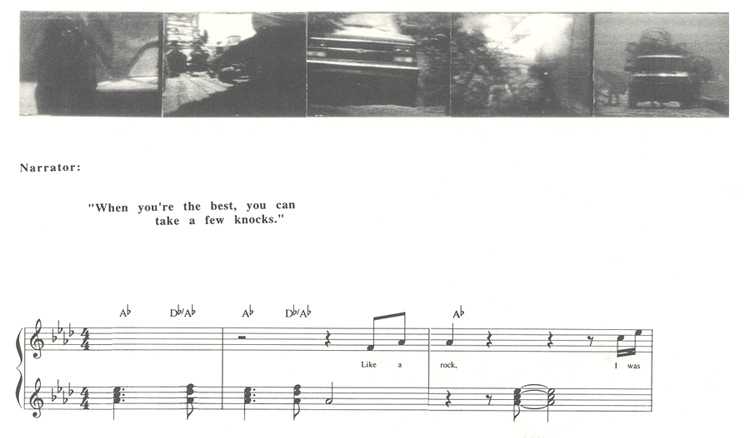
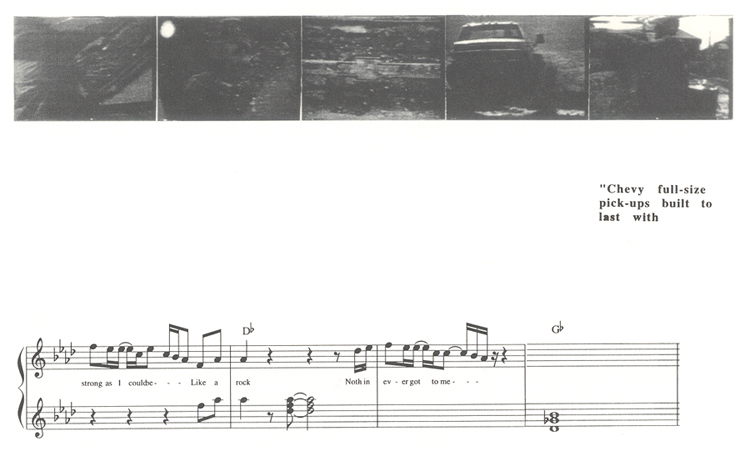
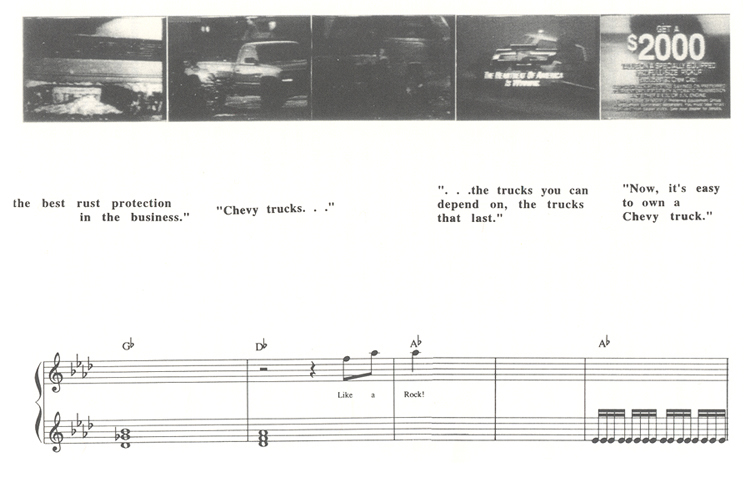
Unlike the Infiniti commercial, the visual images are not organized into a narrative-syntagmatic design, but instead into a loose montage effect. Though not a narrative, the montage unifies the commercial through images of working-class men: pictures of hard-working men are juxtaposed with those of Chevy trucks plowing through fields and bearing heavy loads of construction equipment.
The syntagma of visual images in the commercial open with the darkened images of two hard-hatted men hoisting an American flag dissolving into two more men throwing construction material into the back of a truck. The third image shows a portion of the front of the truck, and this picture dissolves into a picture of the side of the truck driving though a field. Additional images consist of hard-hat construction workers working, lifting, loading, welding, and braving the harsh winter, with other images of Chevy trucks driving relentlessly through open fields of mud and withstanding various forms of abuse, such as severe loads and welding sparks. The representations are obvious: toughness and durability. The commercial seeks a correlation of the tough workers and the tough trucks. Through the representation of toughness, the ideology transmitted is also clear: American capitalism is tempered with a blue collar work ethic.
Despite the ideology portrayed, the visual techniques used in the ad exhibit aspects not commonly associated with toughness. As shown in Figure 5, the visual images of the ad rely heavily on some rather unconventional cinematic codes found mostly in art film of the 1920's through the 70's. First, the rapid visual montage effects are usually considered a highly artistic cinematic technique which was developed by Sergei Eisenstein in his films of the 1920's. Secondly, most of the visual images are shot in synecdoche, another artistic technique in which only part of a whole object is photographed. Finally, as the example shows, many of the shots are quite underexposed and dark, revealing an influence of film noir. If anything, these artistic touches of the camera shots would serve to undermine the representation of the tough, American blue-collar worker.
Despite the conflicting representation of the images, the music in the commercial serves to reinforce the representation of toughness in the commercial. Whereas in the Infiniti commercial music contributes to the visual narrative of the ad, the music of the Chevy truck commercial actually serves the primary narrative function that holds the disparate visual images together. The syntagmatic structure of the song and lyrics is one of a narrative or story: the singer (Seger) sings of his strength ("Like a rock/ I was strong as I could be/ Like a rock/ Nothin' ever got to me . . . ). The song also contains the rhetorical delivery of a gospel sermon with its continuous crescendo to its peak. Unlike the Infiniti commercial, the song demonstrates a tonally open tonal design: the commercial does not end on tonic, but on a "fade-out" on the dominant played by the electric guitar (see the last measure of Figure 5). The fade-out and inconclusiveness of the tonal design signifies the longevity of the Chevy truck, as the music appears to "keep going," as does the truck.
The style topic of the music in the commercial can be considered as an amalgam of country western and rock, even though Seger does not consider himself a country-western artist. The timbral space of the ad consists of electric guitar, acoustic guitar, electric bass and drums, a typical ensemble for either country or rock groups (though acoustic guitar is more prevalent in country groups). Much of the appeal of the song lies in the sound of Seger's husky voice, and in the repetitive quality of the lyrics.22 Though he does not consider himself a country singer, Seger's voice could qualify as a country timbre.
The other musical spaces reinforce this notion of style topic. The simple chord progression in the song (I-IV- -IV-I) is that found in both rock and country styles, though it is appropriated by country from older rock genres. (The
-IV-I) is that found in both rock and country styles, though it is appropriated by country from older rock genres. (The  may be viewed as a dominant substitution). The diatonic and pentatonic pitch space is that used in country music, eschewing the more-prevalent blues scale of many rock genres.
may be viewed as a dominant substitution). The diatonic and pentatonic pitch space is that used in country music, eschewing the more-prevalent blues scale of many rock genres.
The correlation of country music (or country/rock) with the visual images of the blue collar workers is a powerful force for semiosis in the commercial. Like the images, country/rock represents the masculine, working-class blue-collar American worker (see Figure 3). This semiosis transmits the ideology of the ad, much of which is explicit: the preservation of the American work-ethic and the American way of life. Through an ideology of patriotism, the other ideologies of capitalism and class are maintained in a status quo. Seger's song is a celebration of the blue collar American ideology, which is perhaps the primary reason for its success on television. It has come to signify toughness and durability for a class of Americans as well as the product it represents. "Like a Rock" has become a veritable "jingle" for Chevy trucks, and has enjoyed a remarkable longevity in televisual marketing, even though Seger's original intent for the song was quite different.23
IV. Conclusion
Music plays a large role in the process of signification through the hierarchy of codes from reality to representation to ideology. As shown above, analyzing music on television from both syntagmatic and paradigmatic perspectives reveals much about how music contributes to viewer's processing through the hierarchy of codes. Furthermore, this analytic view of music reveals its own hierarchical structure, nested within the larger hierarchy of the codes of television. The musical hierarchy contains as the locus of signification the style topic, an associative structure that bridges the realm of musical reality with that of cultural reality and ideology. The bridge between musical reality and culture is illustrated by the intertextual associations between music in television and other media. American format radio proves a convenient illustration of the musical style topic and its representation of various demographic groups in American society. This same notion of format applies to music in television.
In the two examples of commercials cited here, we have seen how the associative nature of musical style topics enables music to contribute to representation and even directly in the ideology of the ads. In the Infiniti car ad, all technical codes, including music, appeal to the upper class, while in the Chevy truck commercial, these codes appeal to the American male blue collar worker. These illustrations serve to underscore the fact that intertextual relations in the electronic media are so pervasive that our culture consists of a complex web of intertextuality, in which all texts refer finally to each other and thus cultivate an electronic reality.
1John Fiske, Television Culture (London and New York: Routledge, 1987), 1.
2Ibid., p. 5. Fiske defines a "code" as "a rule-governed system of signs, whose rules and conventions are shared amongst members of a culture, and which is used to generate and circulate meanings in and for that culture."
3Ferdinand de Saussure, Course in General Linguistics, edited by Charles Bally and Albert Sechehaye. Translated with an introduction by Wade Baskin (New York, Toronto, London: McGraw-Hill, 1959).
4The types of "formal systems" are: narrative, categorical, rhetorical, abstract, and associational. David Bordwell and Kristin Thompson, Film Form: An Introduction, Fourth Edition (New York, St. Louis, San Francisco: McGraw-Hill, Inc., 1993), 64-140.
5Jeremy Butler, Television: Critical Applications and Methods (Belmont, CA: Wadsworth Publishing Co., 1994).
6Some interesting recent studies on music and narrative include: Fred Maus's "Music as Narrative," Indiana Theory Review 12 (1991), "Musical Narratology" in Lawrence Kramer's Classical Music and Postmodern Knowledge (Berkeley: University of California Press, 1995).
7David Neumeyer and Richard Littlefield, "Narrative Structure and Schenkerian Analysis," Music Theory Spectrum, 14/1 (1992), 39.
8Roman Jakobson, "Language in Relation to Other Communication Systems," in Selected Writings, Vol.2 (The Hague: Mouton, 1971).
9The term "space" is used as it is in other music theory literature. Specifically here, it is taken after Patrick McCreless's article, "Roland Barthes's S/Z from a Musical Point of View," In Theory Only 10 (1988), 1-29.
10Narmour calls style topics "style structures," while Ratner and Agawu use the term "style topics." See Eugene Narmour, The Analysis and Cognition of Melodic Complexity (Chicago and London: The University of Chicago Press, 1992), Leonard Ratner, Classic Music: Expression, Form, and Style (New York: Schirmer Books, 1980), and Kofi Agawu, Playing with Signs: A Semiotic Interpretation of Classic Music (Princeton, NJ: Princeton University Press, 1991).
11Agawu, Playing with Signs, p. 49.
12In his article, "A Theory of Musical Competence," Semiotica 66 (1987), 1-3, Gino Stefani outlines a model of musical competence which describes the relationship between sender and receiver. He presents five levels of musical competence ranging from the most general to the most specific: general codes, social practices, musical techniques, styles, and opus. My hierarchy presented below may be seen as an amplification of the latter three levels of Stefani's hierarchy (and thus as a more structuralist view).
13E. Rothenbuhler and T. McCourt, "Commercial Radio and Popular Music: Processes of Selection and Factors of Influence," in J. Lull (ed.), Popular Music and Communication (Newbury Park, CA: Sage Publications, 1992).
14Ken Barnes, "Top 40 Radio: A Fragment of the Imagination," in Simon Frith, ed., Facing the Music (New York: Pantheon, 1988).
15This list is based on a list of radio formats compiled by Barnes in the 1980's, but is also similar to Kofi Agawu's universe of style topics for eighteenth century music. However, my list is not historical, but reflects "contemporary" musical style. See also John W. White's use of a similar list in this issue, pp. 3-4.
16Nicholas Cook, "Music and Meaning in the Commercials," Popular Music 13 (1994), 35.
17Copyright, Nissan (1991) Infiniti and the Infiniti logo are registered trademarks of Nissan.
18I was unable to find the composer of the commercial, even after discussions with the Nissan Motor Corporation, U. S. A.
19Agawu calls this phenomenon the "beginning-middle-ending paradigm."
20Quoted in an article in the Village Voice, May 17, 1992.
21Copyright, Chevrolet Division of General Motors Corporation (1992).
22Roland Barthes regards the quality or "grain" of the voice as essential in deriving pleasure from music. See his Image, Music, Text. Essays selected and translated by Stephen Heath (New York: Hill and Wang, 1977).
23An interesting critique of the song can be found in Rolling Stone 475/50 (June 5, 1986).


